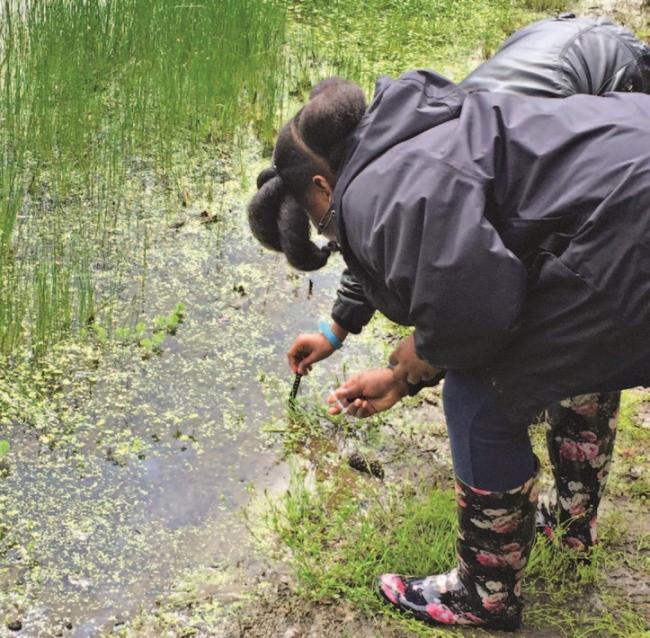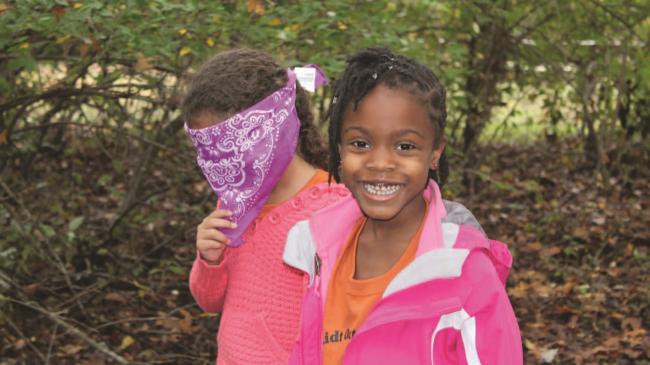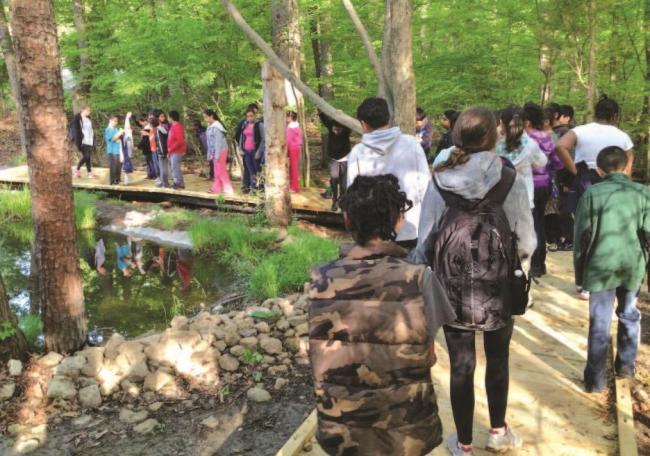Sections / Articles
A Field Guide to Designing Outdoor Learning Experiences
Green learning works with creativity and collaboration. Here’s how one Maryland district has tackled it.
By Sylvester Conyers, Donald Belle, and Mary Kate Bransford
Principal, November/December 2016
 Fourth graders in Maryland are restoring the Chesapeake Bay, one fish at a time. Students in Maryland’s Prince George’s County Public Schools (PGCPS) raise bluegill sunfish—helpful to the Bay’s ecosystem— over the course of the school year. They feed and observe the olive-colored fish, test water quality, and map habitats. In May or June, students release their fish into the slow-moving waters of the Chesapeake during a full-day field trip.
Fourth graders in Maryland are restoring the Chesapeake Bay, one fish at a time. Students in Maryland’s Prince George’s County Public Schools (PGCPS) raise bluegill sunfish—helpful to the Bay’s ecosystem— over the course of the school year. They feed and observe the olive-colored fish, test water quality, and map habitats. In May or June, students release their fish into the slow-moving waters of the Chesapeake during a full-day field trip.
This intensive, hands-on adventure wouldn’t be possible without the district’s William S. Schmidt Outdoor Education Center, a 450-acre outdoor campus that’s the nucleus of the district’s environmental literacy efforts. In 2010, after Maryland implemented environmental literacy standards as a graduation requirement, PGCPS developed a comprehensive, interdisciplinary green education plan that emphasizes outdoor learning. Now, the district uses the Schmidt Center—a facility with a nature center and cabins built and updated in the 1960s and 1970s—for day trips, overnight trips, teambuilding exercises, nature walks, and more.
In the outdoor classrooms, students have the opportunity to view the world differently. But most importantly, outdoor learning experiences teach students how to create and maintain a positive relationship between themselves and the environment around them.
Flora, Fauna, and Focus
Outdoor classrooms connect students with nature while raising their consciousness about environmental topics. Students can explore industrial discharge, renewable and nonrenewable resources, recycling, water systems, and air quality in concrete, real-life terms. In the long run, this can help drive students to actively participate in improving the environment.
 Green education stimulates the senses and mind. Research by Sarah Haines and colleagues at Towson University published in Applied Environmental Education & Communication found strong correlation between schools that participate in the Green School process and improved schoolwide academic performance on standardized tests in reading, math, and science.
Green education stimulates the senses and mind. Research by Sarah Haines and colleagues at Towson University published in Applied Environmental Education & Communication found strong correlation between schools that participate in the Green School process and improved schoolwide academic performance on standardized tests in reading, math, and science.
Andrea Faber et al. published the study “Coping with ADD: The Surprising Connection to Green Play Settings” in Environment and Behavior, which demonstrates how outdoor learning supports students’ cognitive functioning, reduces the symptoms of attention deficit disorder, increases self-discipline, and boosts emotional well-being. Outdoor classrooms are an antidote to what author Robert Louv calls nature-deficit disorder. That’s the state humans are in when we’re cut off from nature: our senses are dulled; we have more attention problems and higher rates of physical and emotional illnesses.
Plus, in urban districts (like Prince George’s County), many students don’t have easy access to parks, water sites, or forests to view wildlife. So, our plan is to provide students with opportunities to learn about the environment using their school, home, and community as outdoor classrooms.
What Green Learning Looks Like
Maryland’s environmental literacy is based around MWEEs: meaningful watershed educational experiences. Students are required to have at least one full MWEE in elementary, middle, and high school. The essential elements of a MWEE are:
1. Issue Definition: Students explore a local environmental issue through classroom instruction, experiments, and student-led inquiry.
2. Outdoor Field Experience: Students conduct research outdoors in order to gather data, answer research questions, and inform their actions.
3. Action Projects: Students participate in student-led, age-appropriate projects taking action at a personal or societal level.
4. Synthesis and Conclusion: Students process their learning and communicate their findings with their community.
Outdoor learning activities should be student-centered, promoting engagement through observation, investigation, data collection, analysis, and reflection. Activities should occur outside, rain or shine.
The teacher’s role is to facilitate and promote exploration through inquiry-based learning. Here are a few examples of our grade-specific programs.
First grade: Environmental education must start early to impact students’ attitudes toward and engagement in addressing environmental issues. In first grade, we offer an introduction to outdoor education. On day trips to the outdoor classroom and a newly constructed native garden, students rotate in small groups through activities on dendrology, soils and decomposition, native birds and their adaptations, animal tracks, insects, and pollinators.
Fifth grade: Every fifth-grade student is provided with the opportunity to have an overnight visit at the Schmidt Center. Activities are designed to help students feel comfortable in the outdoors and develop a positive attitude toward the environment. Their projects may include a deer population survey, water quality testing, orienteering, nature hikes, team building, and high and low ropes courses. Evening activities include a wagon ride and campfire. Parents are encouraged to come on the trip to share the experience with their children.
Seventh grade: In seventh grade, students participate in a wild rice conservation program. Students research the history of the wild rice plant and the significance it has for migratory birds and reducing watershed pollutants. Students use indoor grow stands to raise wild rice from seed and record its growth. In the spring students plant the wild rice in a local body of water.
Green Literacy and Conservation
Beyond facilitating specific grade-level programs, outdoor classroom centers can also promote districtwide literacy and conservation initiatives. The Schmidt Center environmental literacy department supports programs in kindergarten, as well as grades 1, 4, and 7 and high school, with plans to expand to more grades in the future. In the kindergarten Growing Up Green program, teachers partner with professional teaching artists to design art programs that focus on the themes of plant and animal life cycles, habitats, and local ecosystems. Students use their local schoolyard habitats as the site for a field study.
 The Schmidt Center also coordinates a system-wide initiative called Treating and Teaching, which focuses on reducing storm water runoff on school grounds. One of its key strategies is for schools to build school gardens and outdoor classrooms. The staff at the Schmidt Center also work with schools to develop and implement plans for the Maryland Green School Awards Program. Hands-on projects for it include building vegetable or butterfly gardens, and installing birdhouses, bird feeders, or rain barrels.
The Schmidt Center also coordinates a system-wide initiative called Treating and Teaching, which focuses on reducing storm water runoff on school grounds. One of its key strategies is for schools to build school gardens and outdoor classrooms. The staff at the Schmidt Center also work with schools to develop and implement plans for the Maryland Green School Awards Program. Hands-on projects for it include building vegetable or butterfly gardens, and installing birdhouses, bird feeders, or rain barrels.
Steps for Green Success
An outdoor classroom initiative should be built on these three elements for success.
1. Shared buy-in and leadership. To create a green classroom or outdoor learning program, start with executive leadership. District leaders must be convinced that outdoor classrooms are an essential component for all students to achieve environmental literacy. Define the idea clearly and develop a plan to achieve the goal, with measurable objectives and a timeline for implementation. Share the idea with parents, teachers, and various stakeholders. Don’t forget your custodians! They are responsible for the maintenance and upkeep of the school facilities and their buy-in is essential. Solicit feedback from both for-profit and nonprofit environmental organizations and ask how they may be able to support the initiative.
In order to ramp up an existing environmental literacy program, get your students involved. If students are engaged in identifying relevant environmental issues and designing action projects, the whole school quickly becomes invested in the outcome. Projects should be transdisciplinary—touching on language arts, math, social studies, and science—so that it’s not just relegated to the science teacher. The project should be equally owned by everyone. Administrators and teachers can reach out to local NGOs who fund school-based projects such as building a garden or providing water-testing kits.
2. Ties to professional development. Student environmental literacy and outdoor classroom work must be linked to quality teacher professional development. In Prince George’s County, the Schmidt Center regularly conducts professional learning sessions for teachers either at Schmidt or sites throughout the county. Teachers may feel uncomfortable conducting outdoor lessons and may prefer the familiarity and comfort of their indoor sanctuary. So, in professional learning sessions, teachers are given strategies on how to conduct effective outdoor learning activities for students. Schmidt Center staff work to boost teachers’ comfort with and knowledge about the outdoors.
3. Community partnerships. In Prince George’s County, we created an environmental advisory committee in the fall of 2014. It consists of representatives from the district central office, colleges and universities, county government, local environmentally affiliated nonprofits, and business partners. Partnerships with local organizations such as the Alice Ferguson Foundation, Real School Gardens, Anacostia Watershed Society, and the Chesapeake Bay Trust have been essential in providing schools with the opportunity to train staff, take students on outdoor field experiences, and fund and build outdoor classrooms.
Meaningful environmental education supports students’ learning now, but it also plants an important seed for our world’s future. It can inspire students to make thoughtful decisions regarding the issues impacting the world. Outdoor classrooms promote a greater appreciation for and understanding of the fragile nature of our environment to sustain and support life.
Sylvester Conyers is supervisor at the William S. Schmidt Outdoor Education Center.
Donald Belle and Mary Kate Bransford are outreach educators there.
Copyright © National Association of Elementary School Principals. No part of the articles in NAESP magazines, newsletters, or website may be reproduced in any medium without the permission of the National Association of Elementary School Principals. For more information, view NAESP's reprint policy.
| Attachment | Size |
|---|---|
| FieldGuide_ND16.pdf | 2.5 MB |